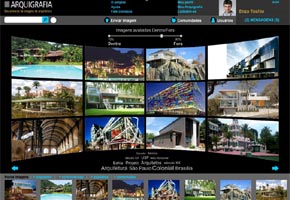

Gold medals go to projects for social networks for architectural photographs, biosensors for tumor markers and genetic markers for poultry production
Gold medals go to projects for social networks for architectural photographs, biosensors for tumor markers and genetic markers for poultry production
Gold medals go to projects for social networks for architectural photographs, biosensors for tumor markers and genetic markers for poultry production

Gold medals go to projects for social networks for architectural photographs, biosensors for tumor markers and genetic markers for poultry production
By Fábio de Castro
Agência FAPESP – Universidade de São Paulo’s USP Agency of Innovation released the final results of its Innovation Olympics. The award ceremony was held on November 17 in São Paulo, with more than 100 participants in attendance.
In the “Applied Social and Human Technologies” category, the gold medal went to the “Archigraphy” project, which was funded in part by FAPESP under the Regular Research Award program.
The project was coordinated by four USP researchers: Artur Rozestraten of the Architecture and Urbanism School (FAU), Maria Laura Martinez of the Communication and Arts School(ECA), and Marco Gerosa and Fabio Kon, both of the Institute of Mathematics and Statistics (IME).
The gold medal in the category “Exact, Earth and Engineering Technologies” was awarded to “Contactless conductometric biosensor in microchips: a potential alternative for determination of tumor biomarkers,” led by professors Emanuel Carrilho and Claudimir do Lago and researchers Wendell Coltro and Renato Lima of USP’s São Carlos Chemistry Institute (IQSC). Coltro and Lima have post-doctoral and doctoral fellowships from FAPESP.
Carrilho coordinates the project “Glycomic study of alpha-dystroglycan and of the glycoproteic profile of dystrophic animal models,” funded by FAPESP under the Regular Research Award program.
First place in the “Health and Biological Technologies” category went to “Differential Maxillary Orthopedic Expansion Device,” a project conducted by Rita de Cássia Moura Carvalho Lauris and Daniela Gamba Garib Carreira, researchers at the Craniofacial Anomalies Rehabilitation Hospital (HRAC) of the USP Odontology School.
Carreira coordinates the project “Evaluation of dentoskeletal and periodontal effects of differential rapid maxillary expansion in patients with bilateral complete cleft lip and palate”, financed by FAPESP under the Regular Research Award program.
In the “Agrarian Technologies” category, the project “Genetic markers applied to poultry raising” took first prize. The project was conducted by Luiz Lehmann Coutinho, Andrezza Maria Felício, and Aline Silva Mello Cesar (who have FAPESP doctoral fellowships) – and Gustavo Gasparin, researchers at the Animal Biotechnology Lab at USP’s Luiz de Queiroz Agricultural School (Esalq).
Coutinho coordinates the project “Centralized multiuser laboratories of functional genomics applied to livestock and agroenergy,” financed by FAPESP under the auspices of the Multiuser Equipment Program.
The multidisciplinary team of “Arquigraphy,” led by Artur Rozestraten, professor in FAU-USP’s Department of Technology, created a social network for sharing photographic material on Brazilian architecture.
“This is a collaborative environment for visualization, interaction and sharing of digital architectural images on the internet with the objective of stimulating collective construction of knowledge about this topic,” Rozestraten told Agência FAPESP.
“Initially, the project will be concentrated on photographic images of architecture. But as it is supported by freeware, it will expand with sharing of drawings and videos,” he explained.
The social network allows users – researchers, students and professors of architecture – to share personal collections. The network also hosts institutional archives, beginning with FAU-USP’s Image Archive.
The winning project in the “Exact, Earth and Engineering Technologies” category consisted of an integrated microfluidic biosensor system with contactless condumetric transduction – an unprecedented configuration, according to IQSC-USP researchers. The objective of the project is to facilitate the realization of in vitro diagnoses of tumor biomarkers circulating in blood plasma.
The winner in the category “Agrarian Technologies,” a project conducted by Esalq-USP researchers, consisted of SNP genetic markers associated with the characteristics of slaughter poultry production, such as muscular development, performance and meat quality. According to the authors, the marker allows for the identification of animals with favorable genotypes for economic characteristics of interest within the population.
The winning project in the “Health and Biological Technologies” section, according to HRAC-USP Bauru researchers, involved orthodontological expansion braces with two screws for the upper dental arch. The objective of the project is to produce specific expansions in the anterior and posterior regions of the dental arch in patients with cleft lips and palates.
Republish
The Agency FAPESP licenses news via Creative Commons (CC-BY-NC-ND) so that they can be republished free of charge and in a simple way by other digital or printed vehicles. Agência FAPESP must be credited as the source of the content being republished and the name of the reporter (if any) must be attributed. Using the HMTL button below allows compliance with these rules, detailed in Digital Republishing Policy FAPESP.





